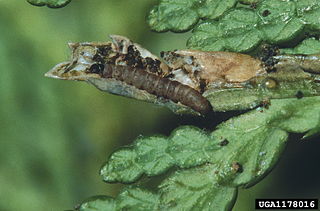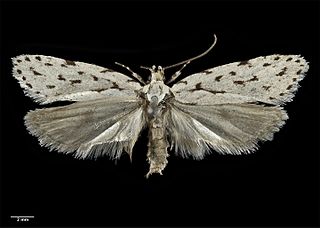
Coleotechnites thujaella is a moth of the family Gelechiidae. It is found in the north-eastern parts of the United States, as well as Canada.

Coleotechnites milleri is a moth of the family Gelechiidae. It is found in the western parts of the United States, as well as Canada.

Hexadactilia trilobata is a moth of the family Pterophoridae described by Thomas Bainbrigge Fletcher in 1910. It is found in Australia in Queensland and New Guinea.

Deuterocopus atrapex is a moth of the family Pterophoridae described by Thomas Bainbrigge Fletcher in 1909. It has been recorded from Sri Lanka, Assam, Selangor, the Tenasserim Hills, south-eastern Borneo, Ternate, Ambon Island, Batian, southern Sulawesi, the Sangihe Islands, Halmahera, Neu Pommern, northern New Guinea, the Kei Islands, the D'Entrecasteaux Islands and Queensland.

Sphenarches zanclistes is a moth of the family Pterophoridae that is found in Australia.

Izatha heroica is a moth of the family Oecophoridae. It is endemic to New Zealand, where it is widespread in the west part of the South Island. It has been collected in southern beech forests but larvae have been reared on dead kanuka or manuka bushes.

Izatha prasophyta is a moth of the family Oecophoridae. It is endemic to New Zealand, where it is known from the North Island, except Hawkes Bay or the Wairarapa. Larvae likely feed on rotting wood although larvae of this species have been reared on the fruiting body of the bracket fungus Bjerkandera adusta. Adults are on the wing from November to February.

Heterocrossa ignobilis is a species of moth in the family Carposinidae. It was described by Alfred Philpott and is endemic to New Zealand and has been observed in Canterbury, in the South Island. Adults are on the wing in January.

Cosmopterix gemmiferella is a moth of the family Cosmopterigidae. It is known from the United States and Canada (Ontario).

Microcolona characta is a moth in the family Elachistidae. It was described by Edward Meyrick in 1897. It is found in New Zealand and Australia, where it has been recorded from New South Wales.
Coleotechnites colubrinae is a moth of the family Gelechiidae. It is found in North America, where it has been recorded from Texas.
Coleotechnites coniferella is a moth of the family Gelechiidae. It is found in North America, where it has been recorded from California, Illinois, Indiana, Maryland, Massachusetts, Michigan, Minnesota, Mississippi, New York, Ontario, Washington and Wisconsin.
Coleotechnites elucidella is a moth of the family Gelechiidae described by William Barnes and August Busck in 1920. It is found in North America, where it has been recorded from California.
Coleotechnites gallicola is a moth of the family Gelechiidae. It is found in North America, where it has been recorded from Colorado and California.
Coleotechnites nigritus is a moth of the family Gelechiidae. It is found in North America, where it has been recorded from Florida, Kentucky and New Hampshire.
Coleotechnites petulans is a moth of the family Gelechiidae. It is found in Colombia, Ecuador and Peru.
Coleotechnites pinella is a moth of the family Gelechiidae. It is found in North America, where it has been recorded from Colorado.
Gnorimoschema ericameriae is a moth in the family Gelechiidae. It was described by Keifer in 1933. It is found in North America, where it has been recorded from California.
Aristotelia ptilastis is a moth of the family Gelechiidae. It was described by Edward Meyrick in 1909. It is found in South Africa, where it has been recorded from the Western Cape.
Gonionota extima is a moth in the family Depressariidae. It was described by Clarke in 1964. It is found in Costa Rica.








